The Best Covered Bridge in Every New England State
Covered bridges are New England icons, so of course we love them all. But if we had to choose just a few…
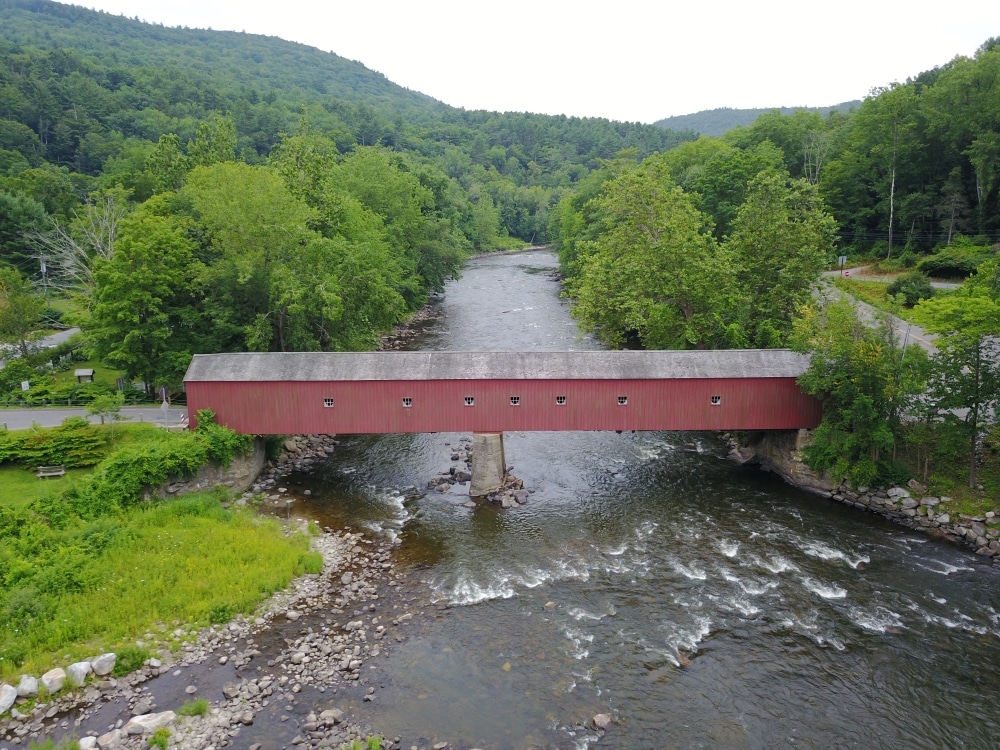
Coffee By Design | Portland, Maine
Photo Credit : Katherine KeenanCreating a list of the best covered bridges is sort of like compiling a tally of the cutest puppies or the most delicious ice creams: The answers can’t really be right or wrong. There is also some debate about what constitutes an “authentic” covered bridge, but we won’t wade into those waters except to say that our list features only bridges with one of the dozen supporting truss structures common to New England bridges. (For the curious, the Covered Bridge Society offers a quick primer on that topic.)
Of course, there are no bad covered bridges, and although new ones are built from time to time, we are losing these iconic structures faster than we gain them. According to the research of Benjamin and June Evans, authors of New England’s Covered Bridges, at least 1,000 covered bridges were constructed in New England during the 19th and early 20th centuries. Today the tally is down around 200. So please, get out and see them all — with the following six bridges being a good place to start.
Best Covered Bridge in Every New England State
Best Covered Bridge in Connecticut:
West Cornwall Covered Bridge
Although the current bridge dates to 1864, records indicate there have been bridges in this same West Cornwall location as early as 1762. Today’s bridge has two native oak spans featuring red spruce Town lattices and, thanks to a later addition, queen trusses. The 172-foot-long one-lane bridge has been modernized several times to keep up with the weight of traffic and was added to the National Register of Historic Places in 1975. As with most covered bridges in New England, the West Cornwall bridge often has been threatened by Mother Nature — perhaps most dramatically in the form of a massive ice jam in 1961, when a strategic dynamite blast was needed to save the day. Painted red for the first time in 1957, this oft-photographed bridge has been featured on many a postcard and even made a guest appearance in the 1967 film Valley of the Dolls.
Best Covered Bridge in Maine:
The Artist’s Bridge
Built three years after the 1869 flood that destroyed a previous bridge at the same location, this nearly-100-foot-long structure in Newry was originally called the Sunday River Bridge, for obvious reasons. The origins of its more recent name, the Artist’s Bridge, are a bit harder to pin down. Some say that early American Impressionist painter John Enneking is the “artist” in question, since he frequented Newry and often painted en plein air near the bridge. Others say the name simply acknowledges that this is one of the most photographed and painted bridges in the state. Built with a Paddleford truss, the bridge was used for vehicular traffic until the 1950s, when a construction project realigned Sunday River Road to bypass it. Listed on the National Register of Historic Places in 1970, it remains open to foot traffic.
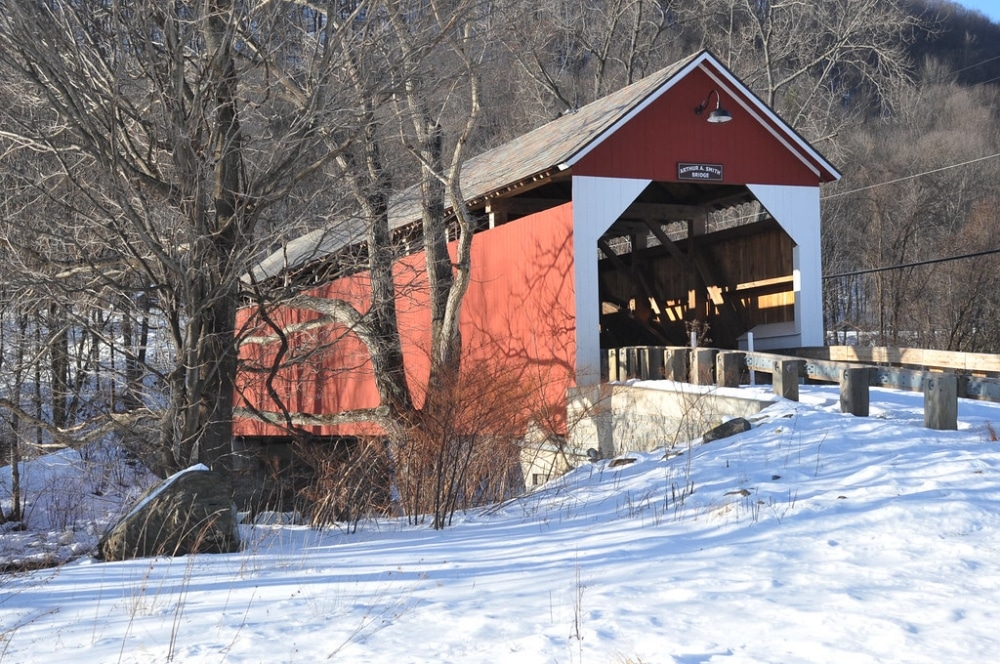
Photo Credit : MacDonald/CC BY-ND 2.0
Best Covered Bridge in Massachusetts:
Arthur A. Smith Covered Bridge
Built in 1869 and listed on the National Register of Historic Places in 1983, the Arthur A. Smith Covered Bridge in Colrain is the only Burr truss bridge in Massachusetts. It also has the distinction of being the only remaining covered bridge in Colrain, a town that once boasted at least a dozen. Originally built in the Shattuckville section of Colrain, the 100-foot-long bridge was badly damaged by an 1878 flood and sat abandoned for several years. In 1896, the town voted to rebuild the bridge and move it to its present Lyonsville Road location, an area called the Arthur A. Smith Flats after the neighborhood’s most prominent resident. In 1991, once again in need of repair, the bridge was taken out of service. Restoration was eventually accomplished between 2005 and 2007, and the bridge was rededicated on May 24, 2008.
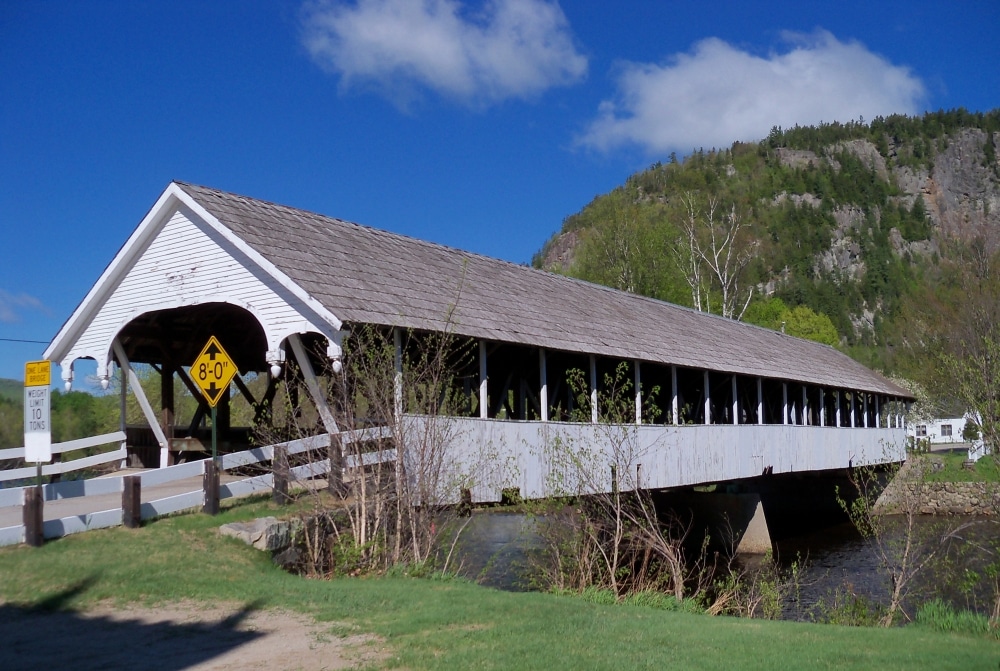
Photo Credit : AlexiusHoratius/CC BY-SA 3.0
Best Covered Bridge in New Hampshire:
Stark Covered Bridge
This might just be New England’s toughest covered bridge. Originally constructed in either 1857 or 1862 (depending on who you ask), the two-span, 151-foot-long Paddleford truss bridge today carries Route 110 over the Upper Ammonoosuc River. A flood in the 1890s washed away both the bridge and its granite support pier, but the intact bridge was “rescued,” dragged back upstream by a team of oxen, and returned to service with a new wooden arch support structure that was later supplemented with a wooden central pier. Although the town voted in the early 1950s to replace the bridge, that plan was abandoned in the face of protests, and in 1954 the bridge was reinforced with steel beams and the current central pier of concrete. It was featured on the town’s bicentennial medal in 1974 and added to the National Register of Historic Places six years later.
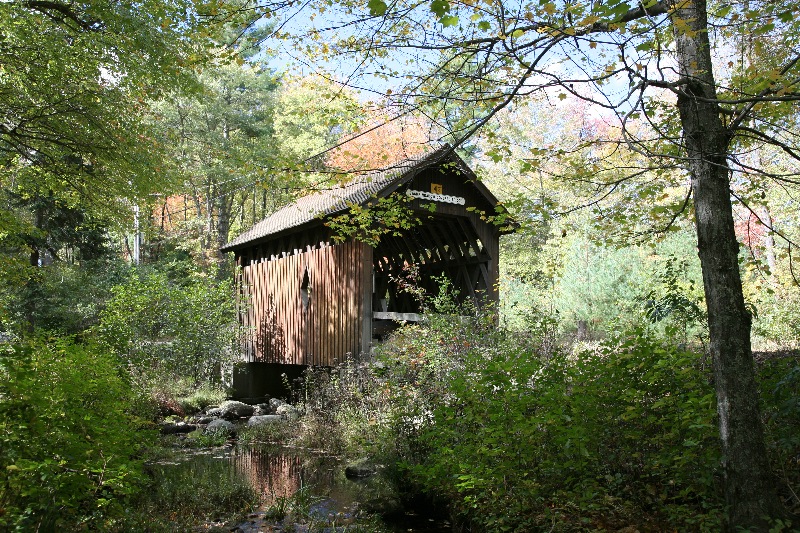
Photo Credit : Dan Wright
Best Covered Bridge in Rhode Island:
Swamp Meadow Bridge
Spanning Hemlock Brook in the town of Foster, Swamp Meadow Bridge is the only covered bridge on a public road in Rhode Island. It is also by far the youngest bridge on this list. In 1986, the town of Foster decided to build a bridge as part of the celebration of Rhode Island’s 350th anniversary that year. After much delay, construction began on September 12, 1992, with all the work being carried out by volunteers. The bridge was dedicated with much ceremony in May 1993, but the celebration was short-lived: On September 11, unknown arsonists set the bridge on fire. Undaunted, volunteers almost immediately set about building the current 40-foot-long Town truss bridge, which was dedicated in November 1994.
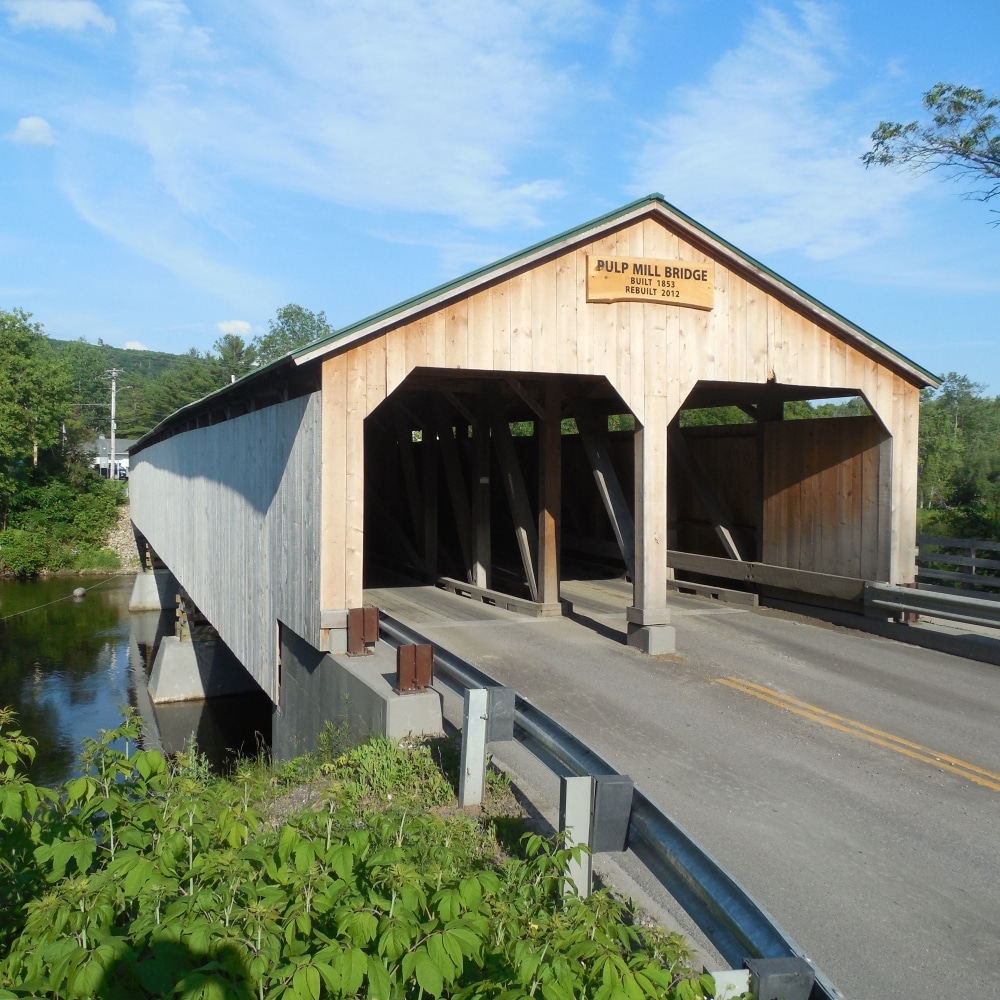
Photo Credit : Arminnius/CC BY-SA 4.0
Best Covered Bridge in Vermont:
Pulp Mill Bridge
As one of only seven “double-barreled” covered bridges in the United States, Pulp Mill Bridge can make you think you’re seeing double. Built to connect the towns of Middlebury and Weybridge, this two-lane bridge is also recognized as the oldest covered bridge in Vermont and one of the oldest in the United States. A sign on the bridge claims that it was built between 1808 and 1820, although some say 1850 is more likely. Originally constructed as a single-span, Burr arch-supported bridge, the structure has been reconfigured several times, with the original arches being supplemented with King post trusses and the addition of stone and concrete piers. It was listed on the National Register of Historic Places in 1974.
Do you have a favorite covered bridge in New England? Let us know!
This post was first published in 2019 and has been updated.




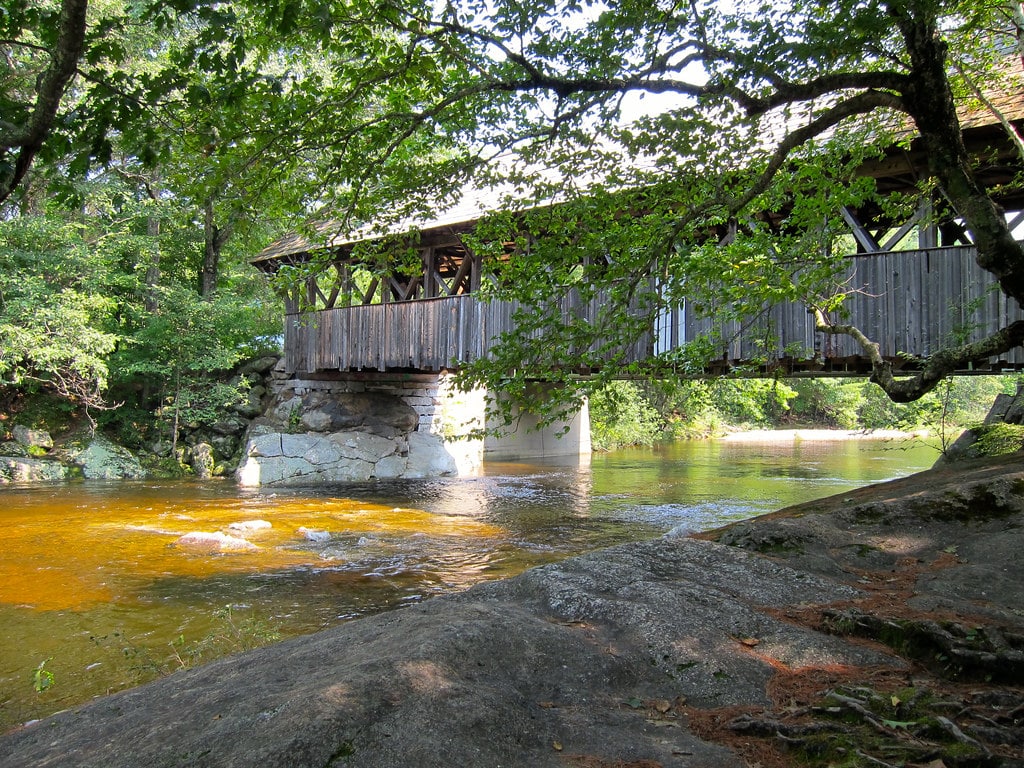

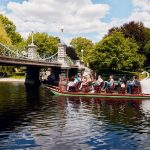


What about the covered bridge that connects Cornish, NH and Windsor, VT?
I know it says in every state but not to list the longest one in the US is crazy. Cornish, NH -Windsor, VT bridge is hands down the best.
living here in the Bennington North Bennington Vermont area we have 3 covered bridges within 2 miles of each one. silk road, henry, and paper village bridges.
They are great too!
Covered bridge in Jackson, NH
I agree!
Just love all of New England !
I agree with the last two comments; what about the Cornish Bridge in N.H.?
My favorites include the Littleton Bridge and the Mt. Orne Bridge over the Ct. River in Lancaster.
There are just too many to say which one is best, especially in Vermont.
Covered Bridge Campground across the Swift River off the Kancamagus.
The Mad River Valley Covered Bridge at Waitsfield, VT is a good one and after several exhaustive searches, it is the only covered bridge on a Web Cam that I could find.
https://www.webcamtaxi.com/en/usa/vermont/waitsfield-covered-bridge.html
I love the secret surprise in the woodsy forest of the Bull’s Bridge over the Housatonic at Kent. One lane, at Dog Tail Corners with the almost spooky Schaghticoke Road on the West Bank and on the east side is the charming Bulls Bridge Inn. Good food, quaint bar.
Thank you for mentioning the Bulls Bridge. I grew up in Kent and traveled over it many times. Great memories.
beautiful and so interesting—what happened to the photo of the covered bridge in Foster, RI ?? i live in RI and have had the pleasure to see it and drive over it.
I was born in NJ but lived in Rupert Vt for 60 yrs and my Dad was born in Rupert in 1906 but we have not got a covered bridge but there is one in West Arlington Vt across the Battenkill River by the Grange a lot of pictures taken there and a great swimming hole too !
Calling these ‘covered bridges’ implies that it’s a bridge that has been covered. But really, the walls and roof are integral to the structure – they are the bridge. Without the rigidity of the sides and roof, the bridge would collapse. Wouldn’t ‘box bridges’ be a more accurate term?
Don’t be a worm
There’s a covered bridge in Shirley Massachusetts. It’s behind a local restaurant called the Bull Run it’s was an old Tavern at one time. Unfortunately you can’t drive on the bridge but you can have dinners or have a weddings there. There’s another covered bridge in Pepperell, Massachusetts it was built around the 1740’s. It has a lot of history with this bridge but unfortunately the original bridge was replaced in 1850. In 1950 another covered bridge was built because of wear and tear of the 1850 bridge. There’s a new covered bridge there that was built and has been opened to traffic since 2010 in the same original spot as the 1740’s bridge.
What about the famous bridge in Vermont that was featured in the movie
The Bridges of Madison County?
The bridge seen in Madison County was not filmed in Vermont. It is in Madison County.
Thanks for your list and pictures! I don’t disagree with your choices, however I agree with one of the comments above about it being difficult to pick just one covered bridge. In Maine I think Hemlock covered bridge outside of Fryeburg and the Porter-Parsonfield covered bridge deserve consideration. In New Hampshire I think the Ashuelot village CB, the Albany CB just off the Kancamagus Highway, the Cornish NH-Windsor VT CB, the Jackson/Honeymoon CB, and the Flume CB also deserve mention.
Middle Bridge in the heart of Woodstock is pretty hard to beat; beautiful bridge in a beautiful town.
“In EVERY state” ?? What about Ohio…among others ?
In NEW England…….!!
Ohio is not part of New England. Article is titled “ Best covered bridges in New England”.
Tho Ohio has some good ones too
What happened to the beautiful covered bridge in Bangor, ME